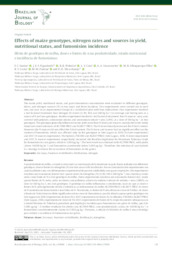Effects of maize genotypes, nitrogen rates and sources in yield, nutritional status, and fumonisins incidence.
Effects of maize genotypes, nitrogen rates and sources in yield, nutritional status, and fumonisins incidence.
Autoria: SANTOS, F. C. dos; FIGUEIREDO, J. E. F.; PINHEIRO, R. B.; COTA, L. V.; VASCONCELOS, A. A.; ALBUQUERQUE FILHO, M. R. de; COSTA, R. V. da; PASTINA, M. M.; ARAUJO, D. D. da S.
Resumo: ABSTRACTS- The maize yield, nutritional status, and grain fumonisins concentration were evaluated in different genotypes, doses, and nitrogen sources (N) in two years and three locations. Two experiments were carried out in each area and year in an experimental design of a subdivided plot with four replications. One experiment involved a 4x2 factorial treatment: four nitrogen (N) doses (0, 80, 160, and 240 kg ha-1) in coverage and having urea as a source of N and two genotypes. Another experiment involved a 4x2 factorial treatment: four N sources: urea, urea covered with polymer, ammonium nitrate, and ammonium nitrate + urea (UAN), at a dose of 160 kg ha-1, in two genotypes. The genotype generally influenced maize yield more than N doses and sources, mainly due to the bushy stunt/corn stunt tolerance of AG7098 PRO2 and AG8677 PRO2. The N doses linearly increased the N leaf content. However, the N sources did not affect the N leaf content. The N doses and sources had no significant effect on the content of fumonisins, which was affected only by the genotypes in Sete Lagoas in 2016 (N doses experiment) and 2017 (N sources experiment). The hybrids, P3630H and AG8677PRO2 (Sete Lagoas, 2016, N doses experiment and 2017, N sources experiment, respectively) exceeded the Brazilian legislation for Maximum Tolerance Limit for fumonisins in corn grains, which is 5,000 µg kg-1. The best result was obtained with AG7098 PRO2, with yields (above 10,000 kg ha-1) and fumonisins consistently below 5,000 µg kg-1. Therefore, the selection of corn hybrids is a strategy to reduce the occurrence of fumonisins in the grains.
Ano de publicação: 2023
Tipo de publicação: Artigo de periódico
Unidade: Embrapa Milho e Sorgo
Palavras-chave: Estado Nutricional, Fertilização, Fumonisina, Fusarium verticillioides, Milho, Nitrogênio, Produtividade
Observações
1 - Por padrão são exibidas publicações dos últimos 20 anos. Para encontrar publicações mais antigas, configure o filtro ano de publicação, colocando o ano a partir do qual você deseja encontrar publicações. O filtro está na coluna da esquerda na busca acima.
2 - Para ler algumas publicações da Embrapa (apenas as que estão em formato ePub), é necessário ter, no celular ou computador, um desses softwares gratuitos. Sistemas Android: Google Play Livros; IOS: iBooks; Windows e Linux: software Calibre.
Acesse outras publicações
Acesse a Base de Dados da Pesquisa Agropecuária (BDPA) para consultar o acervo completo das bibliotecas da Embrapa.

